Planning a trip to the Stikine River, known as the fastest free-flowing navigable river in North America? If so, you may be wondering about the ecology of the river, if it’s affected by pollution, and if it’s safe to take a dip in this wild waterway.
In this guide, we’ll provide an overview of this gorgeous Alaskan and British Columbian river, describe some animals that live in and around it, outline any pollution threats, and provide our informed opinion on the safety of swimming. So, what’s in the Stikine River? Read on to find out.
Overview of the Stikine River
Described as the fastest free-flowing navigable river in North America, the Stikine River begins in the rugged Spatsizi Wilderness Park in northwestern British Columbia. Mountain streams merge from the Stikine Plateau to form this wild river. It flows 379 miles in an arc north, west, and finally south, before draining into the Pacific Ocean near the town of Wrangell, Alaska.
The headwaters of the Stikine River and the surrounding region are known as the Sacred Headwaters to Tahltan people. In this stunning alpine basin, the Skeena, Nass, and Stikine Rivers are formed. All of these waterways are among the greatest salmon rivers in British Columbia.
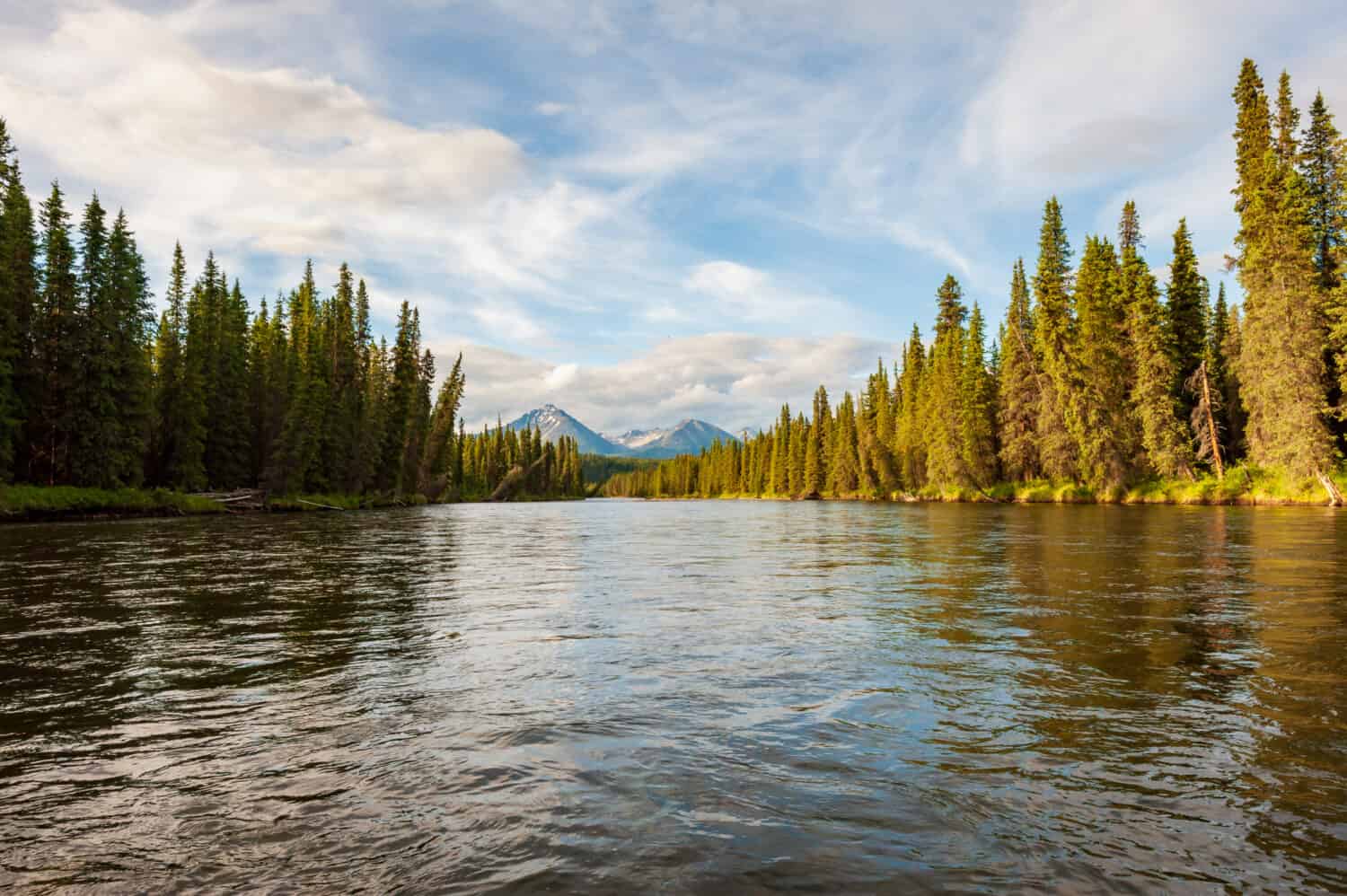
The Stikine River flows 379 miles from western British Columbia into southeastern Alaska, before emptying into the Pacific Ocean.
©Salparadis/Shutterstock.com
What’s in the Stikine River: Pollution Threats
Currently, the Stikine River is not acutely affected by pollution. However, the river conservation organization, American Rivers, listed the Stikine in 2019 as one of America’s most endangered rivers due to an operational mine at its headwaters- the Red Chris Mine- and other mineral-extraction mines that are proposed to operate nearby. In 2018, the environmental justice non-profit law organization, Earthjustice, submitted a petition to the Inter-American Commission on Human Rights. This petition, representing 15 sovereign tribal nations of Southeast Alaska, outlined a multitude of concerns on the impact of operating and proposed mines in Canada that are posing a substantial environmental risk to the Stikine, Taku, and Unuk rivers and their watersheds.
Imperial Metals owns the Red Chris Mine. This company is responsible for a catastrophic dam failure in 2014 at the Mount Polley Mine site. The failure polluted surrounding lakes and rivers with 17 million cubic meters of water mixed with 8 million cubic meters of toxic mine waste.
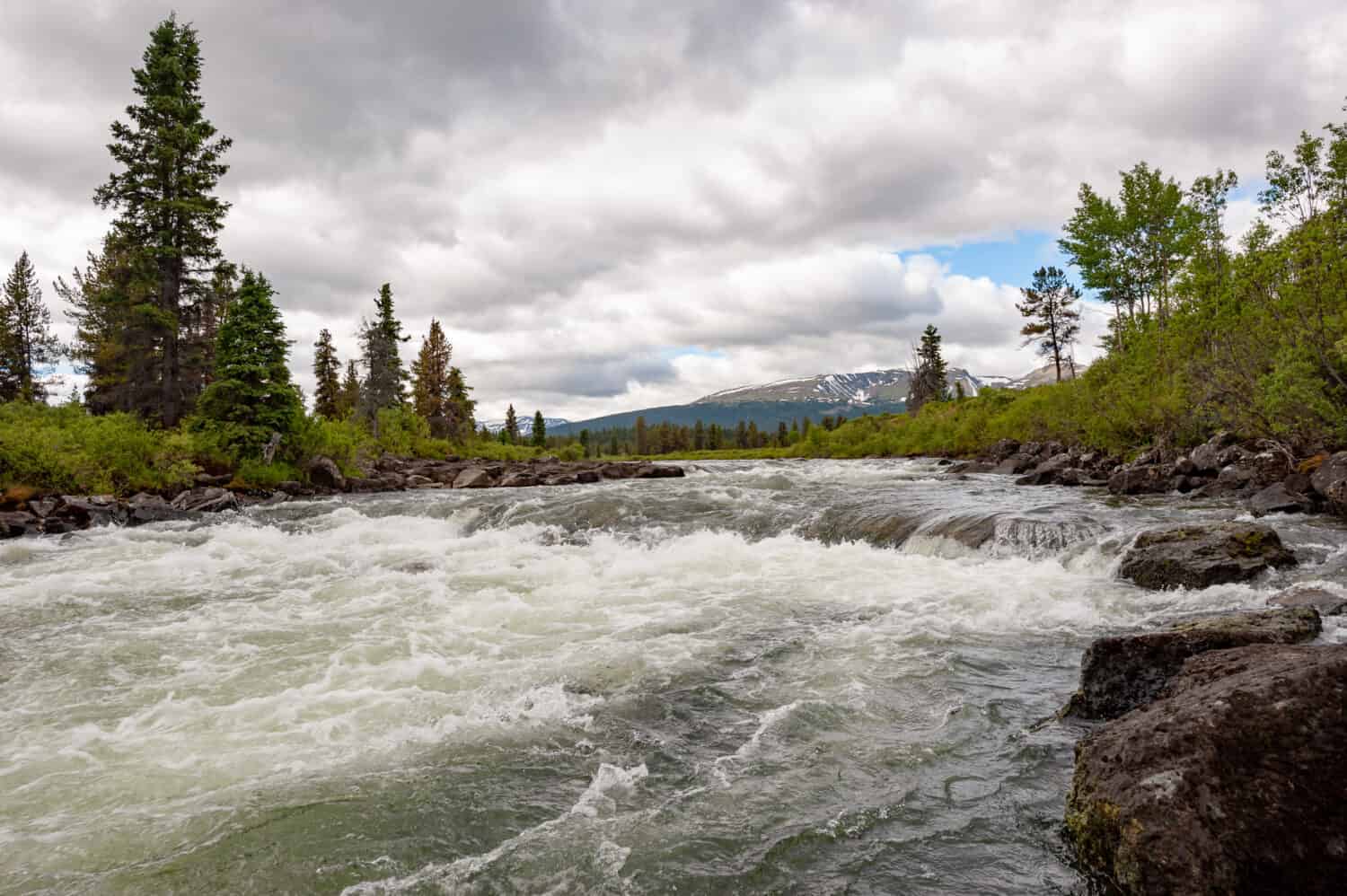
The Stikine River is not acutely affected by pollution.
©Salparadis/Shutterstock.com
Animals of the Stikine River
Across its 379-mile path through Canada, southeastern Alaska, and into the northern Pacific Ocean, the Stikine River is home to a highly diverse ecosystem. It is one of British Columbia’s most important salmon rivers and currently hosts all five North American species of Pacific salmon. Large mammals such as grizzly and brown bears, moose, and wolves use the river for fresh water, feeding, and cooling off. Dozens of migratory birds depend on the Stikine as a stopping point in their travels.
Below, we’ll take a closer look at four species of animals that call the waters and surrounding regions of the Stikine River home.
Sockeye Salmon (Oncorhynchus nerka)
In the past couple of years, about 50,000 sockeye salmon (Oncorhynchus nerka) have swam through the Stikine River on the annual runs. This is far below the previous 10-year average of about 145,000 fish per terminal run. Commercial fishing, industrial civilization-fueled climate change, and habitat degradation and loss are the mass threats to the Stikine sockeye salmon. Along with the other four species of Pacific salmon, the sockeye has been an integral part of the cultural, subsistence, and spiritual practices of dozens of indigenous tribes along the Stikine River and its watershed.
These sockeye salmon are sea-going, making the voyage to southeastern Alaska where they enter the Pacific Ocean at 1-3 years of age. After spending about 2-3 years at sea, sockeye salmon return to freshwater to spawn. They die a few weeks after spawning, and their total lifespan is about 4-5 years.
Before they enter the ocean, sockeye salmon are iridescent silver with a white belly and metallic green-blue back. Once in the Pacific Ocean, the sockeye salmon gain 99% of their body mass. In the ocean, their diet is mostly carotenoid-rich shrimp and krill. This diet turns the body of the sockeye a vibrant pink-red.
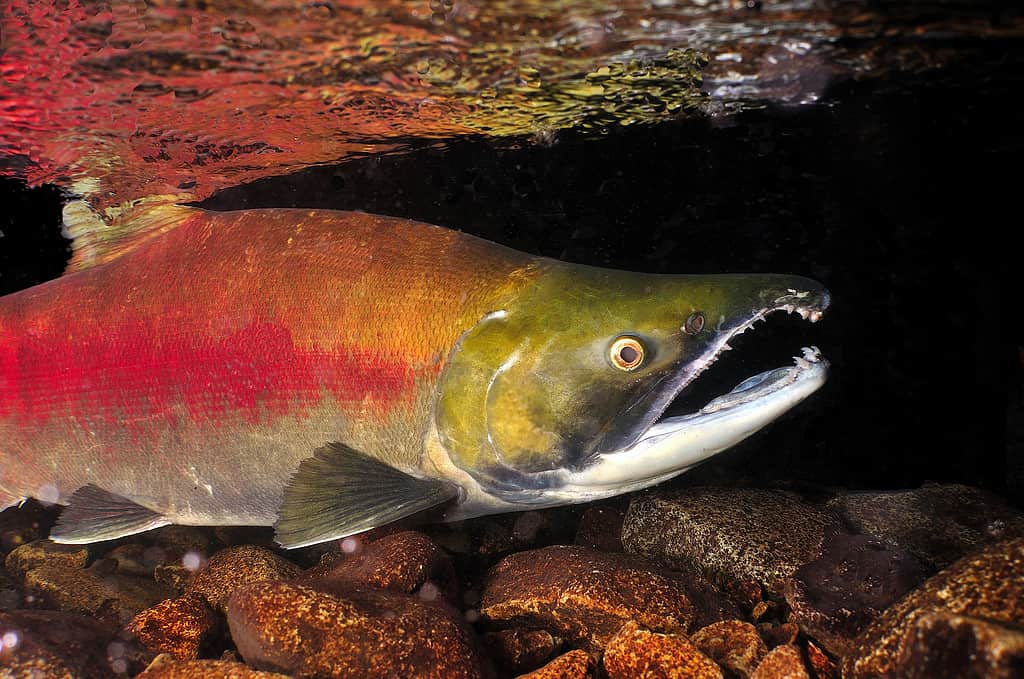
Sockeye salmon acquire their red hue from their oceanic diet of krill and shrimp.
©Eduardo Baena/iStock via Getty Images
British Columbian Wolf (Canis lupus columbianus)
The British Columbian wolf (Canis lupus columbianus) is a subspecies of gray wolf native to parts of British Columbia and the Alexander Archipelago of southeastern Alaska. Along the Stikine, this wolf is most common along the southern portion of the river. This subspecies of gray wolf currently enjoys a healthy population.
The diet of British Columbian wolves is quite varied, although they feed primarily on moose, elk, deer, and caribou. They supplement this primary diet of large ungulates with hares, birds, rodents, fish (especially salmon), and beavers.
This subspecies of gray wolf weighs 80-150 pounds and typically features black fur mixed with tan and gray. In the wild, their lifespan averages 4-10 years, although some individuals have lived up to 15 years. They primarily inhabit coastal and temperate rainforest environments.
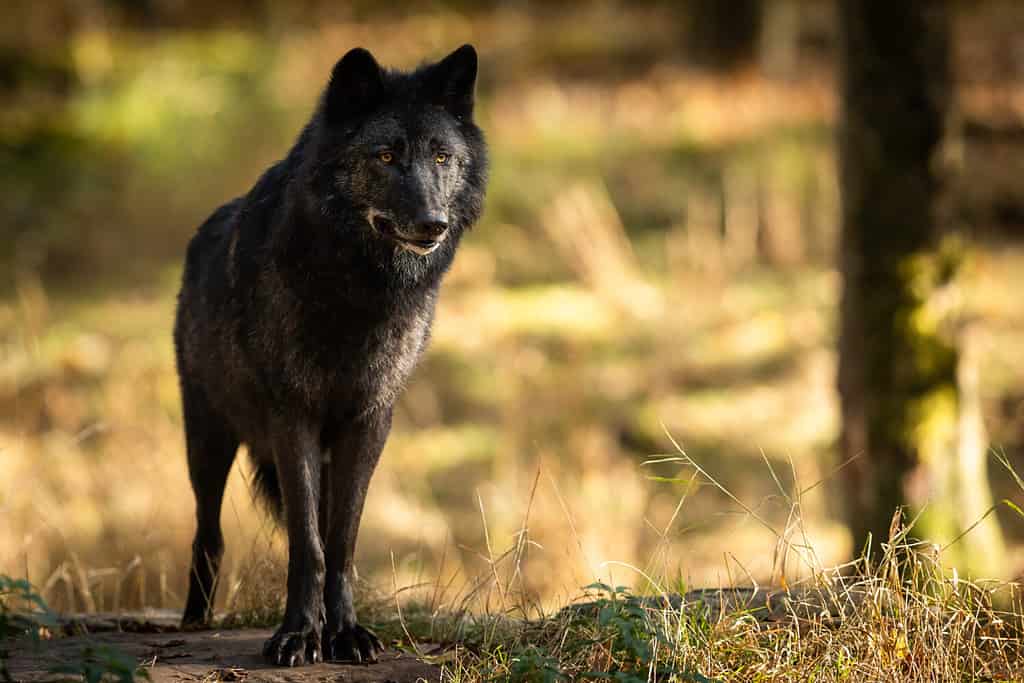
The British Columbian wolf inhabits the southern portion of the Stikine River.
©AB Photographie/Shutterstock.com
Rocky Mountain Goat (Oreamnos americanus)
Along the southern portion of the Stikine River, Rocky Mountain goats inhabit the Coast Range of Southeast Alaska. Visitors to the southern portion of the Stikine may spot these magnificent animals along the mountainous terrain that borders this section of the river. Or, if you’re lucky, you may even see them gathering by the river to drink. This region of the Stikine River is famous for hosting enormous mountain goats. The current world record for the largest hunted Rocky Mountain goat was from the Stikine River region.
These powerful climbers can measure up to 40 inches at the shoulders. They typically weigh from 180 to over 300 pounds. Around the Stikine River, they inhabit altitudes from sea level to about 9,000 ft. These animals are browsers and grazers, depending on their habitat and the time of the year. During the warmer months, they typically graze on high alpine meadows. In the fall and winter, mountain goats will switch to browsing.
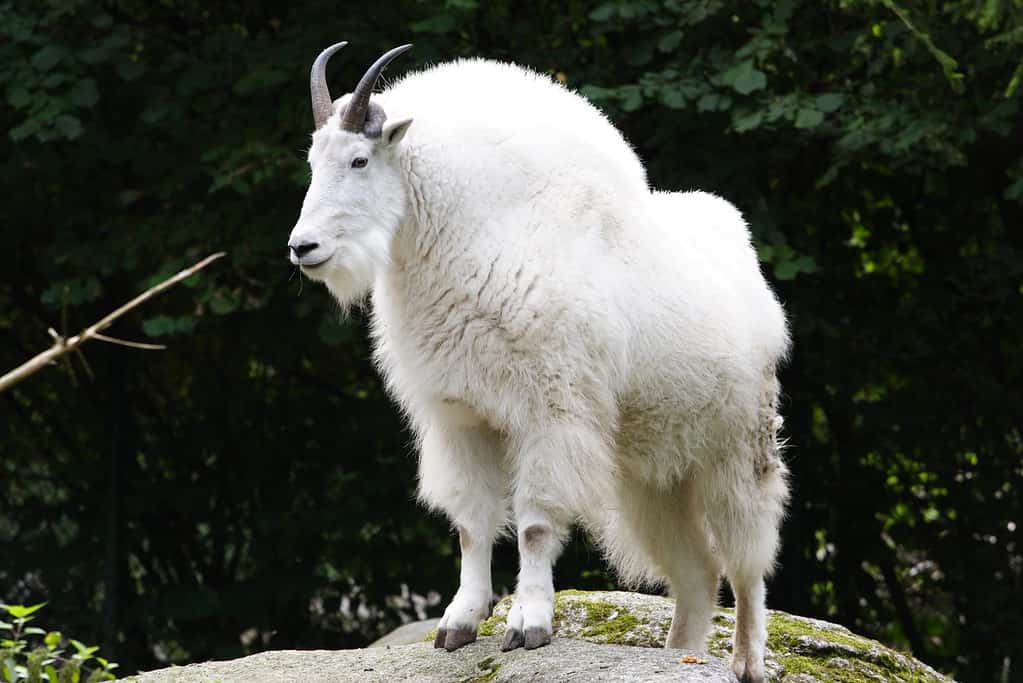
Rocky Mountain goats inhabit the Coast Range of southeastern Alaska which the Stikine River flows through.
©Robert Asenjo/Shutterstock.com
Brown Bear (Ursus arctos)
In the central and northern parts of the Stikine River, grizzly bears (Ursus arctos horribilis) make use of this waterway for drinking and hunting fish. Along the coastal range, biologists refer to this species as the brown bear (Ursus arctos).
While brown and grizzly bears are the same species, in North America, they are currently distinguished by habitat, with brown bears inhabiting coastal ranges and grizzlies living further inland. Brown bears tend to be much larger due to their calorie-dense marine diet. Both grizzlies and brown bears inhabit parts of the Stikine River, with brown bears inhabiting the southernmost portion. They both feed heavily on the five species of salmon that call the Stikine home.
Grizzly bears can measure up to 3.5 feet tall at their shoulders and weigh between 200-700 pounds. Brown bears, who fatten themselves up on marine diets, can weigh up to 1,500 pounds. On the Stikine River, you’re most likely to see bears fishing for salmon in July and August.

Both brown and grizzly bears inhabit portions of the Stikine River where they fish for all five of the North American Pacific salmon species.
©Michal_K/Shutterstock.com
What’s in the Stikine River: Is It Safe to Swim?
The Stikine River is predominantly fast-flowing and cold. We do not advise swimming due to these environmental risks. However, many people enjoy kayaking down this wild river. Additionally, during the warmest months of the year when you might be tempted to take a dip, brown and grizzly bears frequent these waters to fish. Kayaking, fishing, and wildlife viewing are the best activities to partake in along the Stikine. If you see a brown or grizzly bear on your visit to this river, stay at least 250 feet away. This can reduce the chance of confrontation.
The photo featured at the top of this post is © Salparadis/Shutterstock.com
Thank you for reading! Have some feedback for us? Contact the AZ Animals editorial team.







